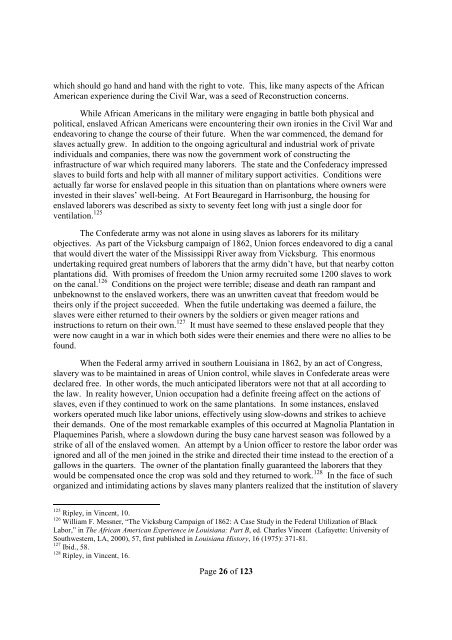The African American Experience in Louisiana
The_African_American_Experience_in_Louisiana
The_African_American_Experience_in_Louisiana
- No tags were found...
Create successful ePaper yourself
Turn your PDF publications into a flip-book with our unique Google optimized e-Paper software.
which should go hand and hand with the right to vote. This, like many aspects of the <strong>African</strong><br />
<strong>American</strong> experience dur<strong>in</strong>g the Civil War, was a seed of Reconstruction concerns.<br />
While <strong>African</strong> <strong>American</strong>s <strong>in</strong> the military were engag<strong>in</strong>g <strong>in</strong> battle both physical and<br />
political, enslaved <strong>African</strong> <strong>American</strong>s were encounter<strong>in</strong>g their own ironies <strong>in</strong> the Civil War and<br />
endeavor<strong>in</strong>g to change the course of their future. When the war commenced, the demand for<br />
slaves actually grew. In addition to the ongo<strong>in</strong>g agricultural and <strong>in</strong>dustrial work of private<br />
<strong>in</strong>dividuals and companies, there was now the government work of construct<strong>in</strong>g the<br />
<strong>in</strong>frastructure of war which required many laborers. <strong>The</strong> state and the Confederacy impressed<br />
slaves to build forts and help with all manner of military support activities. Conditions were<br />
actually far worse for enslaved people <strong>in</strong> this situation than on plantations where owners were<br />
<strong>in</strong>vested <strong>in</strong> their slaves’ well-be<strong>in</strong>g. At Fort Beauregard <strong>in</strong> Harrisonburg, the hous<strong>in</strong>g for<br />
enslaved laborers was described as sixty to seventy feet long with just a s<strong>in</strong>gle door for<br />
ventilation. 125<br />
<strong>The</strong> Confederate army was not alone <strong>in</strong> us<strong>in</strong>g slaves as laborers for its military<br />
objectives. As part of the Vicksburg campaign of 1862, Union forces endeavored to dig a canal<br />
that would divert the water of the Mississippi River away from Vicksburg. This enormous<br />
undertak<strong>in</strong>g required great numbers of laborers that the army didn’t have, but that nearby cotton<br />
plantations did. With promises of freedom the Union army recruited some 1200 slaves to work<br />
on the canal. 126 Conditions on the project were terrible; disease and death ran rampant and<br />
unbeknownst to the enslaved workers, there was an unwritten caveat that freedom would be<br />
theirs only if the project succeeded. When the futile undertak<strong>in</strong>g was deemed a failure, the<br />
slaves were either returned to their owners by the soldiers or given meager rations and<br />
<strong>in</strong>structions to return on their own. 127 It must have seemed to these enslaved people that they<br />
were now caught <strong>in</strong> a war <strong>in</strong> which both sides were their enemies and there were no allies to be<br />
found.<br />
When the Federal army arrived <strong>in</strong> southern <strong>Louisiana</strong> <strong>in</strong> 1862, by an act of Congress,<br />
slavery was to be ma<strong>in</strong>ta<strong>in</strong>ed <strong>in</strong> areas of Union control, while slaves <strong>in</strong> Confederate areas were<br />
declared free. In other words, the much anticipated liberators were not that at all accord<strong>in</strong>g to<br />
the law. In reality however, Union occupation had a def<strong>in</strong>ite free<strong>in</strong>g affect on the actions of<br />
slaves, even if they cont<strong>in</strong>ued to work on the same plantations. In some <strong>in</strong>stances, enslaved<br />
workers operated much like labor unions, effectively us<strong>in</strong>g slow-downs and strikes to achieve<br />
their demands. One of the most remarkable examples of this occurred at Magnolia Plantation <strong>in</strong><br />
Plaquem<strong>in</strong>es Parish, where a slowdown dur<strong>in</strong>g the busy cane harvest season was followed by a<br />
strike of all of the enslaved women. An attempt by a Union officer to restore the labor order was<br />
ignored and all of the men jo<strong>in</strong>ed <strong>in</strong> the strike and directed their time <strong>in</strong>stead to the erection of a<br />
gallows <strong>in</strong> the quarters. <strong>The</strong> owner of the plantation f<strong>in</strong>ally guaranteed the laborers that they<br />
would be compensated once the crop was sold and they returned to work. 128 In the face of such<br />
organized and <strong>in</strong>timidat<strong>in</strong>g actions by slaves many planters realized that the <strong>in</strong>stitution of slavery<br />
125 Ripley, <strong>in</strong> V<strong>in</strong>cent, 10.<br />
126 William F. Messner, “<strong>The</strong> Vicksburg Campaign of 1862: A Case Study <strong>in</strong> the Federal Utilization of Black<br />
Labor,” <strong>in</strong> <strong>The</strong> <strong>African</strong> <strong>American</strong> <strong>Experience</strong> <strong>in</strong> <strong>Louisiana</strong>: Part B, ed. Charles V<strong>in</strong>cent (Lafayette: University of<br />
Southwestern, LA, 2000), 57, first published <strong>in</strong> <strong>Louisiana</strong> History, 16 (1975): 371-81.<br />
127 Ibid., 58.<br />
128 Ripley, <strong>in</strong> V<strong>in</strong>cent, 16.<br />
Page 26 of 123


